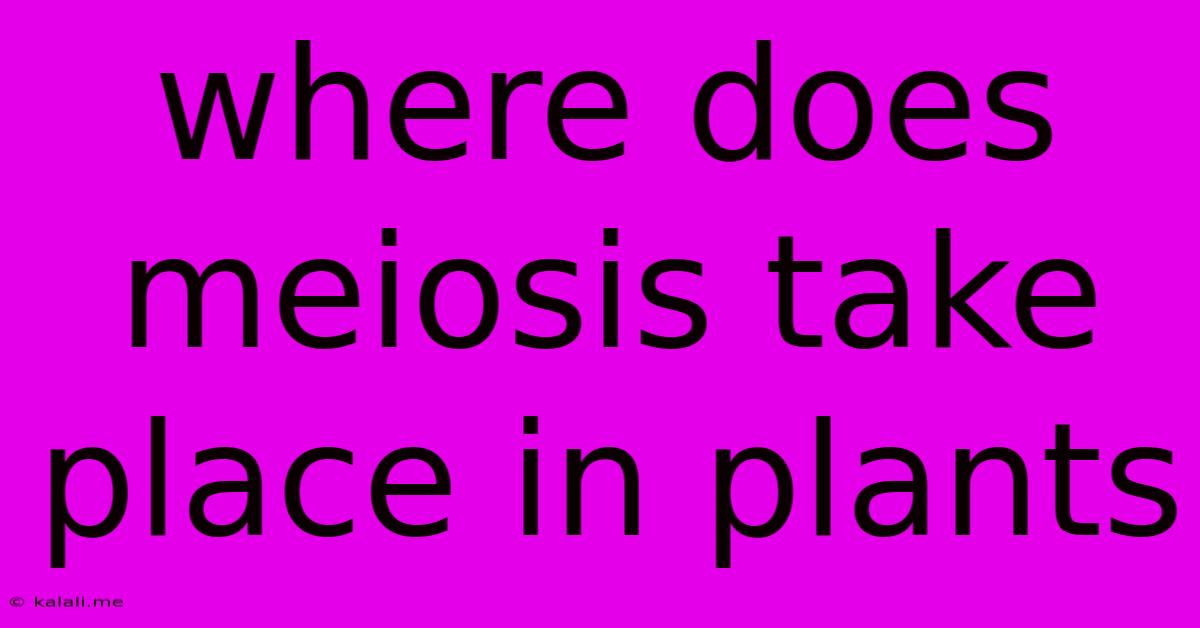Where Does Meiosis Take Place In Plants
Kalali
Jun 15, 2025 · 3 min read

Table of Contents
Where Does Meiosis Take Place in Plants? A Comprehensive Guide
Meiosis, the specialized type of cell division that reduces the chromosome number by half, is crucial for sexual reproduction in all eukaryotes, including plants. Understanding where this process occurs within the complex plant structure is key to comprehending plant life cycles and reproduction. This article explores the specific locations in plants where meiosis takes place, focusing on the differences between angiosperms (flowering plants) and gymnosperms (cone-bearing plants).
The Importance of Meiosis in Plant Reproduction: Before diving into the location, it's important to understand why meiosis is vital. Meiosis produces haploid gametes (sperm and egg cells) with half the number of chromosomes as the parent cell. This is essential because when these gametes fuse during fertilization, the resulting zygote restores the diploid chromosome number, maintaining genetic stability across generations. Without proper meiosis, genetic abnormalities and reproductive failure would result.
Meiosis in Angiosperms (Flowering Plants)
In angiosperms, the location of meiosis is intimately tied to the flower's reproductive structures. Specifically, meiosis takes place in two key locations:
-
Microsporogenesis (in the anthers): This process occurs within the anthers, the pollen-producing structures of the stamen (male reproductive organ). Here, diploid microsporocytes (pollen mother cells) undergo meiosis to produce four haploid microspores. These microspores then develop into pollen grains, each containing a male gamete (sperm cell). This ensures the male gametes have the correct haploid chromosome number, ready for fertilization.
-
Megasporogenesis (in the ovules): Meiosis also takes place within the ovules, located inside the ovary (female reproductive organ) of the flower. A single diploid megasporocyte (megaspore mother cell) undergoes meiosis, typically producing four haploid megaspores. However, three of these usually degenerate, leaving only one functional megaspore. This functional megaspore undergoes further mitotic divisions to develop into the female gametophyte, also known as the embryo sac, which contains the female gamete (egg cell).
Meiosis in Gymnosperms (Cone-bearing Plants)
While the overall process of meiosis is similar, its location differs slightly in gymnosperms due to their reproductive structures:
-
Microsporogenesis (in the microsporangia of male cones): In gymnosperms, pollen is produced in the microsporangia located within the male cones (also called pollen cones or staminate cones). Diploid microsporocytes within the microsporangia undergo meiosis, producing haploid microspores that develop into pollen grains containing male gametes.
-
Megasporogenesis (in the megasporangia of female cones): The female gametophyte develops within the megasporangia of the female cones (also called ovulate cones or seed cones). A single megasporocyte undergoes meiosis, resulting in typically four haploid megaspores, although, similar to angiosperms, only one usually survives. This surviving megaspore develops into the female gametophyte, containing the egg cell. The female gametophyte in gymnosperms is more complex than in angiosperms, often consisting of many cells.
Key Differences Summarized:
| Feature | Angiosperms | Gymnosperms |
|---|---|---|
| Male Meiosis | Anthers (within stamens) | Microsporangia (within male cones) |
| Female Meiosis | Ovules (within ovaries) | Megasporangia (within female cones) |
| Female Gametophyte | Relatively simple, embryo sac | More complex, multicellular |
| Reproductive Structure | Flowers | Cones |
Understanding the precise location of meiosis in plants is fundamental to comprehending plant reproduction and genetics. This knowledge is crucial in fields like plant breeding, genetic engineering, and evolutionary biology, enabling scientists to manipulate plant reproduction for various purposes. Further research into the specific cellular mechanisms and genetic control of meiosis in different plant species continues to expand our understanding of plant life.
Latest Posts
Latest Posts
-
An Individuals Personality Is The Sum Of Their
Jun 15, 2025
-
Lichens Are Symbiotic Associations Of Fungi And
Jun 15, 2025
-
Which Planet Can Float On Water
Jun 15, 2025
-
California State University Fullerton Gpa Requirements
Jun 15, 2025
-
New College Of Florida Gpa Requirements
Jun 15, 2025
Related Post
Thank you for visiting our website which covers about Where Does Meiosis Take Place In Plants . We hope the information provided has been useful to you. Feel free to contact us if you have any questions or need further assistance. See you next time and don't miss to bookmark.